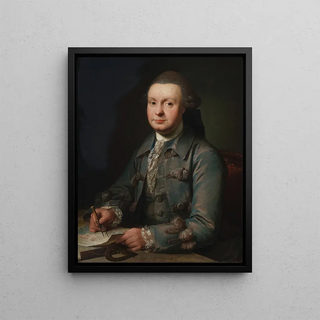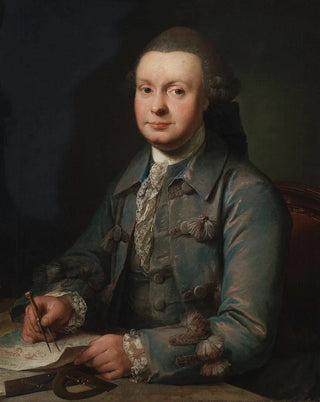Art print | Peder Rahr, merchant in Ribe - Jens Juel


View from behind

Frame (optional)
In the fascinating world of 18th-century Danish painting, the artwork "Peder Rahr, merchant in Ribe" by Jens Juel stands out as a valuable testament to the era. This portrait, capturing the essence of an influential businessman, immerses us in an atmosphere where commerce and art harmoniously intersect. Through Juel's gaze, we are invited to explore not only Peder Rahr's personality but also the socio-economic context of his time. The painting, rich in detail and emotion, proves to be much more than a simple portrait: it reflects a society in full transformation, where social status and personal ambitions intertwine.
Style and uniqueness of the work
Jens Juel, known for his skill in capturing the psychological nuances of his subjects, deploys here a style that combines realism and elegance. The features of Peder Rahr are rendered with striking precision, each shadow and light contributing to bringing his face to life. The sumptuous clothing he wears, adorned with rich textures and deep colors, testifies to his status as a prosperous merchant. The composition, carefully orchestrated, draws the eye toward the protagonist's face while hinting at elements of his environment, which speak of a thriving commercial world. Juel's mastery of light gives the work an almost tangible atmosphere, where the viewer can feel the gravity and dignity of the man depicted.
The artist and his influence
Jens Juel, an emblematic figure of Danish painting, managed to mark his era with his unique approach to portraiture. Trained abroad, notably in France, he incorporated various influences while developing a distinctly Nordic style. His work helped elevate the portrait to the rank of major art, offering a new perspective on the characters of his time. Juel was able to capture not only the physical appearance of his subjects but also their character and social status, making him a pioneer in the art of portraiture. His ability to establish an emotional connection between the subject and the viewer inspired many artists after him, consolidating his legacy in

Matte finish

View from behind

Frame (optional)
In the fascinating world of 18th-century Danish painting, the artwork "Peder Rahr, merchant in Ribe" by Jens Juel stands out as a valuable testament to the era. This portrait, capturing the essence of an influential businessman, immerses us in an atmosphere where commerce and art harmoniously intersect. Through Juel's gaze, we are invited to explore not only Peder Rahr's personality but also the socio-economic context of his time. The painting, rich in detail and emotion, proves to be much more than a simple portrait: it reflects a society in full transformation, where social status and personal ambitions intertwine.
Style and uniqueness of the work
Jens Juel, known for his skill in capturing the psychological nuances of his subjects, deploys here a style that combines realism and elegance. The features of Peder Rahr are rendered with striking precision, each shadow and light contributing to bringing his face to life. The sumptuous clothing he wears, adorned with rich textures and deep colors, testifies to his status as a prosperous merchant. The composition, carefully orchestrated, draws the eye toward the protagonist's face while hinting at elements of his environment, which speak of a thriving commercial world. Juel's mastery of light gives the work an almost tangible atmosphere, where the viewer can feel the gravity and dignity of the man depicted.
The artist and his influence
Jens Juel, an emblematic figure of Danish painting, managed to mark his era with his unique approach to portraiture. Trained abroad, notably in France, he incorporated various influences while developing a distinctly Nordic style. His work helped elevate the portrait to the rank of major art, offering a new perspective on the characters of his time. Juel was able to capture not only the physical appearance of his subjects but also their character and social status, making him a pioneer in the art of portraiture. His ability to establish an emotional connection between the subject and the viewer inspired many artists after him, consolidating his legacy in






